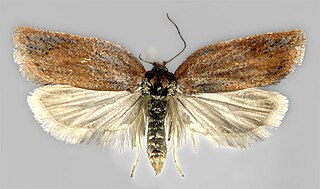
Dyseriocrania subpurpurella is a diurnal moth from the family Eriocraniidae, found in most of Europe. The moth was first named by the English entomologist, Adrian Hardy Haworth in 1828.

Aleimma loeflingiana is a moth of the family Tortricidae. It is found in Europe and the Near East.

Celypha cespitana is a moth of the family Tortricidae. It is found in the Palearctic realm, from western Europe to the Ural Mountains, Transcaucasia, Asia Minor, the Near East, Iran, Russia, north-eastern China (Manchuria), Korea and Japan. It is also found in the Nearctic realm.

Ancylis achatana is a moth of the family Tortricidae. It is found from central and southern Europe including the United Kingdom and Ireland, east to the Baltic region, Asia Minor, Ukraine and Russia to the southern part of Trans-Ural.

Acleris rufana is a moth of the family Tortricidae. It is found from northern, central and south-western Europe through southern Siberia to the Russian Far East and Japan.

Apotomis capreana is a moth of the family Tortricidae. It is found in most of Europe, east to the eastern part of the Palearctic realm.

Cochylis hybridella is a moth species of the family Tortricidae. It is found in most of Europe, the Near East, China, Japan, Korea and Russia.

Apotomis betuletana is a moth of the family Tortricidae. It is found in most of Europe. It is also found in the eastern part of the Palearctic realm. The habitat consists of woods and woodland margins where birch occurs.

Apotomis sororculana is a moth of the family Tortricidae. It is found in most of Europe, and in the eastern part of the Palearctic realm.

Acleris holmiana, the golden leafroller moth, is a moth of the family Tortricidae. It is found in most of Europe and Asia Minor.

Ancylis mitterbacheriana is a species of moth of the family Tortricidae. It is found in most of Europe, except the Iberian Peninsula, most of the Balkan Peninsula and Ukraine.

Ancylis myrtillana is a moth of the family Tortricidae. It was described by Treitschke in 1830. It is found in most of Europe and across the Palearctic.It has also been recorded in North America. The habitat consists of moorland.

Acleris schalleriana, the viburnum button or Schaller's acleris moth, is a moth of the family Tortricidae. It was described by Carl Linnaeus in 1761. It is found in most of Europe. It is also found in North America. Acleris viburnana is a possible synonym that refers to the North American populations.

Cochylis pallidana, the sheep's-bit conch, is a moth of the family Tortricidae. It was described by Zeller in 1847.

Cnephasia longana, the omnivorous leaftier moth, long-winged shade or strawberry fruitworm, is a moth of the family Tortricidae. It was described by Adrian Hardy Haworth in 1811. It is native to western Europe. It is an introduced species in western North America. The species has also been reported from north-western Africa and Asia. The habitat consists of downland and rough ground.

Epinotia nemorivaga, the bearberry bell, is a species of moth in the family Tortricidae. It is found in Europe and Asia.

Cnephasia conspersana is a species of moth of the family Tortricidae. It is found in Ireland, Great Britain, France, Italy, Portugal, Spain and North Africa. The habitat consists of coastal chalk downlands and heathlands.

Ancylis obtusana, the small buckthorn roller, is a moth of the family Tortricidae.

Bactra furfurana, the mottled marble, is a moth of the family Tortricidae described by Adrian Hardy Haworth in 1811. It is found in the Nearctic and Palearctic realms.

Epiblema costipunctana is a species of moth belonging to the family Tortricidae. It is native to Europe.




















